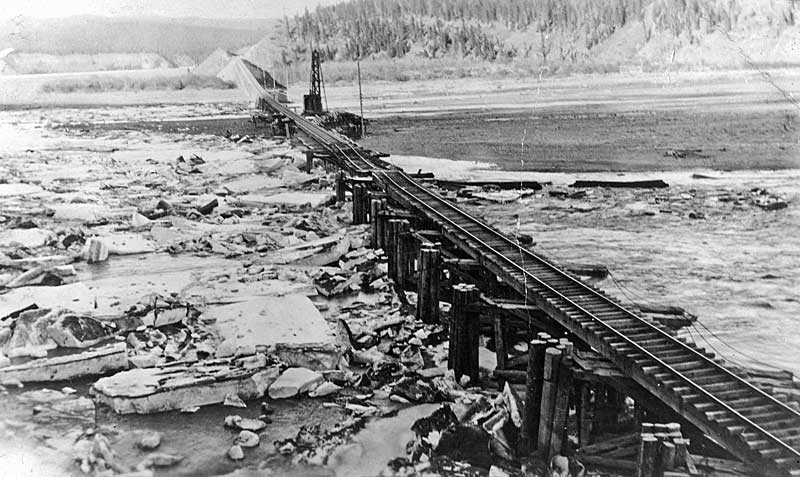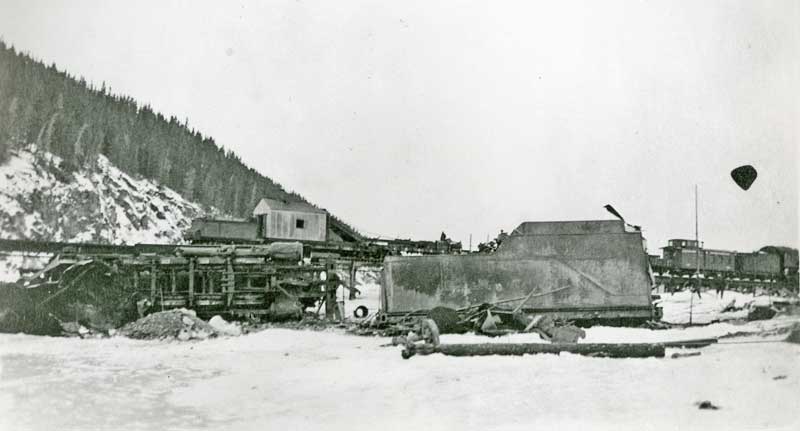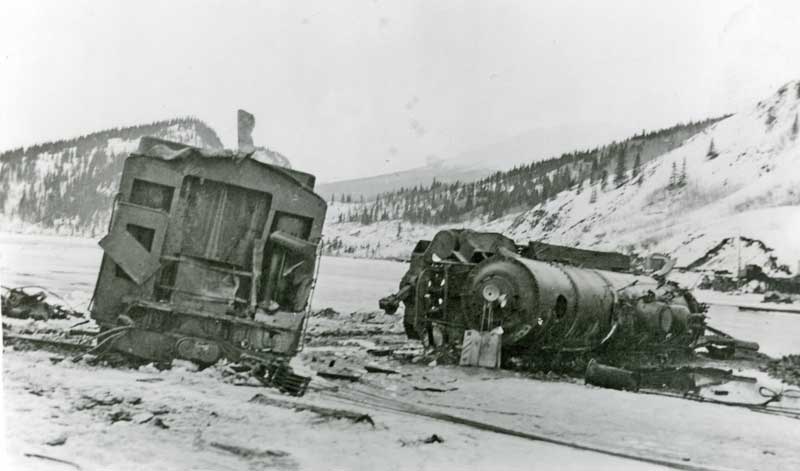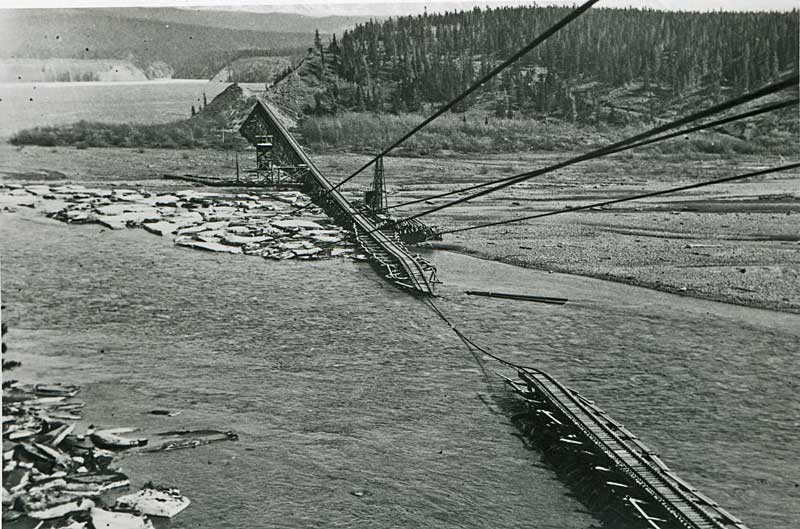
Ice takes out yet another trestle at MP 132
--McCarthy-Kennicott Museum
|
All three engines were chugging contentedly away on the west side of the
newly rebuilt trestle, waiting clearance from the McCarthy maintenance
crew with their small consist headed by ALCO saddle-tank No. 3,
somewhere up the hill on the other side. The sixteen-ton saddle-tank
would be the first locomotive to cross the re-built trestle. Once it
crossed successfully, the way would be cleared for our large consist to
head east.
Our maintenance crew was headed by another Irishman, of which there have
been many since the days when the railway was first started back in
1907. Ten years after construction began, many of those same men were
still working for the company. In that time many of the adult male
Natives at Chitina and Strelna began filling the maintenance crew
rosters. The railroad ran up to three Native crews, depending on the
demand. Eventually, the Indian crews found ways to force the railroad to
use Native foremen to head the Native crews, but in 1917 that had not
happened. In the end, the very iron-horses which so many of our people
feared were kept on the tracks only because of us. And we, in turn, had
learned to depend on those same trains for survival in our modern world.
Nicolai let us know without any doubt that we must work with our white
brethren, particularly those of the railroad, because we must adapt to
the new ways without ever forgetting that we are Ahtna Indians first and
railroad workers second.
A line-shack at the base of the hill on the Chitina side of the Copper
River provided us with cover from the icy winds. Cap and I and several
of the others had been taking turns warming up in there. The hot coffee
was most welcomed on a such a bone-chilling day.
“What do you think Cap? Will this train be moving soon?”
Cap peeked out the door of the line-shack. A cold wind blasted his face,
but he hardly noticed because Chitina Maintenance Local No. 3 train had
reached the base of the hill across the river.
“The saddle-tank is coming across now. What do you think?”
Everyone of us watched as the small engine from McCarthy successfully
crossed. It stopped beyond the first switch south of our line shack and
backed into the siding without a hitch.
With the small McCarthy consist out of the way, the signal man waved his
lantern, then the steam whistle on the Mikado at the front of the line
began blowing its distinctive deep sound. The strength of its metal
throat could be heard clearly for miles up and down the Copper valley.
The engines had already begun building up steam in anticipation of the
hard six-mile climb to Kotsina. Our small crew moved into place to be
ready to jump the flatcars while the engines began to slowly advance
toward the trestle. The combined weights of the two engines and tenders
alone probably exceeded 200 tons. The bridge creaked as the leading edge
of the massive Mikado moved onto the western approach. We watched in
complete silence as the double header crept across, finally reaching
solid ground.
The crew whistled and applauded. We were in business.
I looked at Cap in relief.
“Well, what did you expect?” he shrugged. “It always worked before.”
We did not need any more bad happenings. None of us who worked for the
company wanted to see the entire railroad hexed. We smiled at each other
and took our customary places, jumping aboard the flatcars as the train
completed its crossing of the new bridge over the rushing Copper River.

Someone neglected
to check the bents. The train was allowed to proceed without
running a speeder first. Neither Cap nor I nor any of the Native
crew was there when engine No. 74 crashed through the trestle in
1918 right after our great chief died. No one saw it fall in. .
.A flatcar
points to the spot where the great engine crashed through the
trestle at CRNW mile 132. --Candy Waugaman
Collection
|

Shown is bottom of engine #74 next to its tender that were
retrieved from the bottom of the Copper River in 1918.
--Candy Waugaman Collection
One year later another Mikado would not be so fortunate. Someone
neglected to check the bents. The train was allowed to proceed without
running a speeder first. Neither Cap nor I nor any of the Native crew
was there when engine No. 74 crashed through the trestle in 1918 right
after our great chief died. No one saw it fall in. What a sight that
must have been. We were involved in the potlatch ceremony up at Chittyna
village following the private burial near Taral. The pride of the CRNW
fleet took a fatal dump into the ice-choked river right after Nicolai
himself passed on. None of us believed that was a coincidence. Nicolai
was having the last word, as usual, in his distinctively silent, but
not-so-understated way.
When stationmaster George Brown called us down from the village to help
with the emergency, we found that the 95-ton engine had completely
submerged, taking the tender and one flat car with it. The engineer
somehow survived the plunge into the ice water. The fireman was not so
lucky.
The evil spirit of Taral had taken another life and wrecked the bridge.

The pride of
the CRNW fleet took a fatal dump into the ice-choked river right
after Nicolai himself passed on. None of us believed that was a
coincidence.
Engine No. 74 and its tender sit on the east bank of the
Copper River in the spring of 1918 after being retrieved from the main channel.
The engine appeared to be a complete loss. Not so. It lasted forty-seven more
years. --Candy Waugaman Collection.
|
|
|
How we pulled that massive piece of iron out of the icy rushing river is
another story. Number 74 went on to have the distinction of being the
Last Train Out. Once again, it was the Native crew which proved
essential in rescuing this very last of the great engines because it
took all the manpower the company had at its disposal as well as two
large cranes to retrieve it from the bottom of the sandy river. The
roundhouse crew at Cordova expertly rebuilt it. Number 74 served another
twenty years. This venerable locomotive would be the very last Copper
River and Northwestern Railway engine to be scrapped. That happened at
Chihuahua, Mexico, forty-seven years after it was built and twenty-six
years after the line at Chitina was abandoned.
In the two-dozen actual years of its operation as a working railroad
bridge, the Copper River trestle had the reputation of being the
deadliest place on the railroad. It was probably the most haunted.
Altogether it took fifteen lives. The bridge itself was rebuilt well
over two-dozen times, as if Nicolai himself did not want the trestle to
remain standing for too long. The infamous Copper River crossing between
the Kotsina and the Chitina River confluences, built within sight of
Uk’eledi, Spirit Mountain, Spirit Rock and the promontory of Taral
Creek, will remain forever the most powerful symbol of the curse of
Nicolai.

Chitina trestle washes out for last time in 1939
|
|
No comments:
Post a Comment